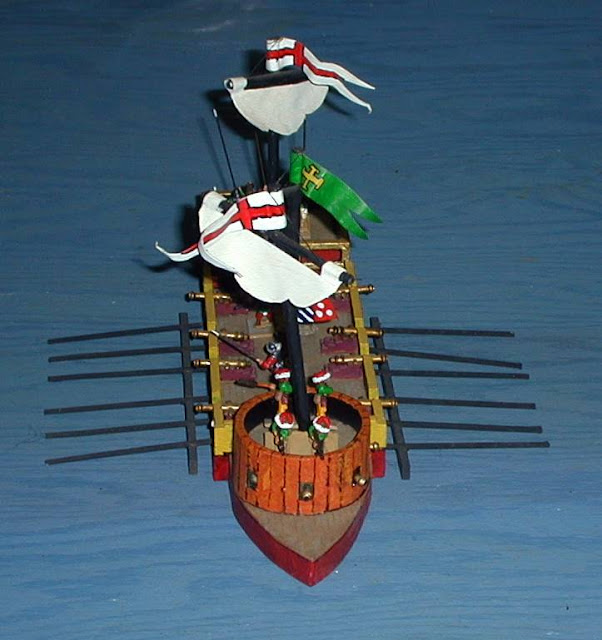Well, here she is; the ship that launched 2 Fleets! I saw this great bit odd looking ship at Merrimack Miniatures (now Old Glory Shipyard; they have since released a new and improved version) back about 15 years ago. I hemmed and hawed over it for a couple of Historicons in a row before finally deciding to buy it!
This is a 15mm Galleass. It has suffered some damage to its masts and rigging in storage which I will need to repair.
A Galleass had three masts, and thus was much more capable under sail than a Galley, but also had a full team of rovers as well, although typically being rather slow under oars, due to their large size and weight.
Typically a Galleass had a high forecastle mounted with multiple guns, as seen here.
More importantly, it was the first ship to have significant broadside guns. They were also typically stoutly constructed. Six Venetian Galleasses played a major role in the decisive Christian victory at the enormous Battle of Lepanto in 1571. The Galleas remained important in Naval warfare through the era of the Spanish Armada, and in the Mediterranean, through about 1700.
Her oars were scratch built based upon those included with the Bill Abrams shops seen here earlier. And how DO you pronounce "Galleass", anyway? I tend to go with "GAL-ee - ass", but have also heard "Gah-LEE-as.
This is another Merrimack ship, a Merchant type round ship.
It usually sees the tabletop as part of a scenario objective.
Mixing the properties of a sailing ship with those of rowed galleys on the same table makes for interesting tactical challenges!
It has no guns, but can still carry some fighting men!
Last ship of the day is this Merrimack Cog. Cogs were used for merchant duties from about 1200 AD on, and also as warships. They could carry some guns, and had a high fore and stern castle, and a stern rudder.
This example needs her mast replaced. Typically a single, large square sail was carried. Cogs were usually sturdily constructed out of oak wood.
The slave girl came with the Ottoman Army purchase, free of charge! Must have been misbehaving...
The Cog is also typically used as part of a scenario objective when it appears on the table.
Video of a Cog, reconstructed from a wreck found off the Southern coast of Sweden in 1991. Cogs were especially commonly found in the Baltic and North Atlantic.













The reconstructed cog visited King's Lynn a while back - very interesting to go round it, really should put some photos of it on my own blog.
ReplyDeletePlease do!
DeleteGreat stuff Gonsalvo, the 16th century Naval Wars in the Mediterranean are a great era to game/collect.
ReplyDeleteIn a way it is like the Land warfare of the time - artillery becomes a serious factor for the first time, gunpowder small arms coexist with bows and crossbows, and hand to hand combat is still vital to win a bate as well. Also the transition from oars to sail (which still wasn't over even 250 years later, at least in the Mediterranean!
DeleteEvery time I see one of these posts I think I really must get back and complete my 15mm renaissance Turks. So little time...
ReplyDeleteYep; "So much lead, so little time!"
DeleteA Wargamer's Lament! :-)
You certainly have an eclectic collection, Peter. Cool stuff all!
ReplyDeleteThe Renaissance ships are probably the most unusual part of my collection, but they have a pretty high "wow" factor, in part because you just don't see them on a wargames table very often!
DeleteGreat looking ships,the galleass is an impressive centrepiece for your fleet
ReplyDeleteIain
Thanks; it's a great model!
DeleteAwesome stuff Peter. I always enjoy this type of eclectica.
ReplyDeleteThanks, Jake!
Delete